- HOME >
- New Arrival at HOJO Online Shop
New Release of Da Xue Shan Wild White Tea 2024
- [2024.08.14] Posted By Akira Hojo
 We have released the 2024 Da Xue Shan Wild White Tea Loose Leaf. This tea was produced under our direct supervision during our stay in Yunnan Province, ensuring meticulous production management on site.
We have released the 2024 Da Xue Shan Wild White Tea Loose Leaf. This tea was produced under our direct supervision during our stay in Yunnan Province, ensuring meticulous production management on site.
Definition of Wild Tea in Yunnan Province
People in Yunnan strongly associate Camellia taliensis with wild tea, regardless of where it is grown. Even if the tea is not from the mountains, they still refer to it as wild tea due to its appearance. This naming convention has made “wild tea” synonymous with Camellia taliensis. Consequently, even if the tea is grown and picked from a tea garden in front of a house in the village, it is still called wild tea. Similarly, in both Yunnan and Japan, plants originally growing in the mountains are called mountain vegetables, even if they are cultivated in fields.
Similarly, both in Yunnan and Japan, plants originally growing in the mountains are referred to as mountain vegetables, even if they are cultivated in fields. This cultural practice highlights how the term “wild tea” has become ingrained in the local vernacular, transcending the actual growing conditions.
However, for those who have never visited the growing areas and instead buy tea from middlemen or local tea shops in Yunnan, they accept the term “wild tea” at face value. This has led to the current situation where teas labeled as wild tea flood the market.
Cultivated Camellia Taliensis Sold as Wild Tea in Yunnan Province
In recent years, due to the popularity of wild tea, Camellia sinensis has been cultivated in various parts of Yunnan Province. Additionally, some farmers in mountainous villages dig up wild tea plants from the mountains and replant them in tea gardens near their villages. Although these are wild species, they are not truly wild tea, yet they are marketed as “wild tea.” For more details, please refer to the following article: https://hojotea.com/en/posts-283/
Based on my experience, over 95 to 99% of the tea labeled as “wild tea” on the market is made from cultivated Camellia taliensis.

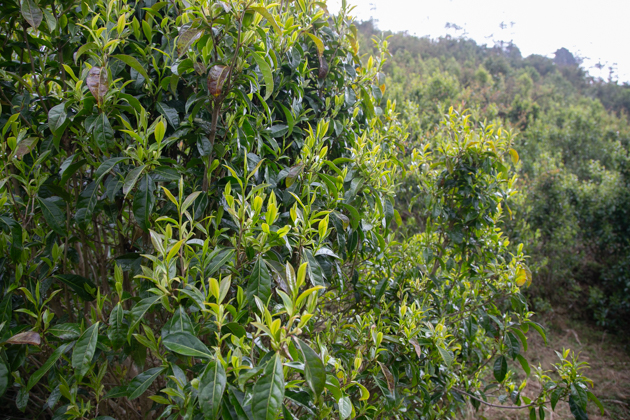 Even within the same Camellia taliensis species, there is a notable contrast in flavor and aroma between genuinely wild tea plants and those transplanted near villages. Specifically, the distinction between authentic wild tea and cultivated varieties is most apparent in the length of the aftertaste. True wild tea boasts a remarkably prolonged aftertaste, highlighting its distinctiveness upon comparison.
Even within the same Camellia taliensis species, there is a notable contrast in flavor and aroma between genuinely wild tea plants and those transplanted near villages. Specifically, the distinction between authentic wild tea and cultivated varieties is most apparent in the length of the aftertaste. True wild tea boasts a remarkably prolonged aftertaste, highlighting its distinctiveness upon comparison.
We are dedicated to sourcing wild Camellia taliensis tea, which involves frequent visits to various regions to meticulously select the freshest tea leaves available.

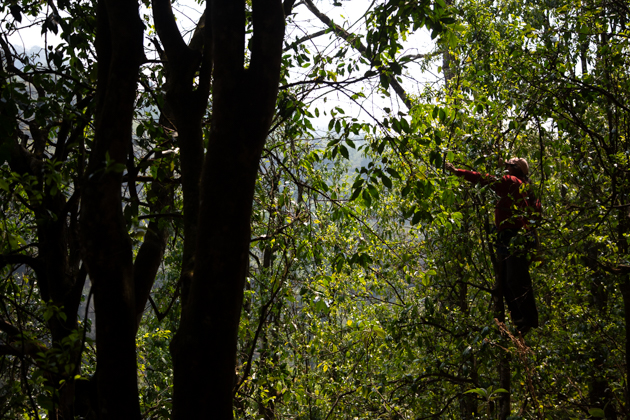 Scenes of wild tea picking
Scenes of wild tea picking 
Producing White Tea with Many Young Buds
Young buds are considered optimal for the production of white tea. As tea leaves develop and mature, their stems thicken, posing challenges during the withering process and increasing the likelihood of over-fermentation. Despite these challenges, tea leaves are typically valued and priced based on weight, leading tea pluckers to prioritize larger, more mature leaves. We consistently monitor the condition of fresh tea leaves and are willing to pay above market prices to secure younger buds specifically for our white tea. This commitment ensures that our wild white tea features many small leaves, offering a unique product not found in other stores.
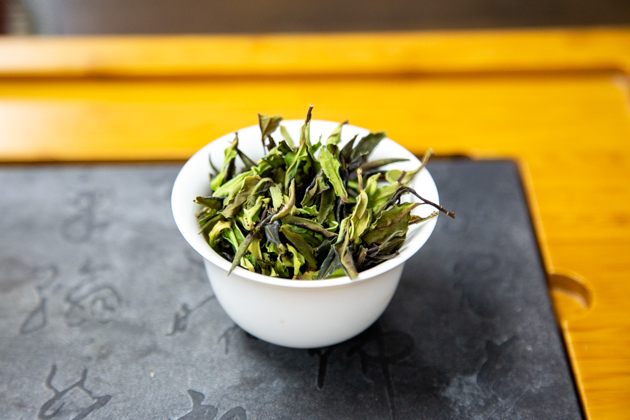
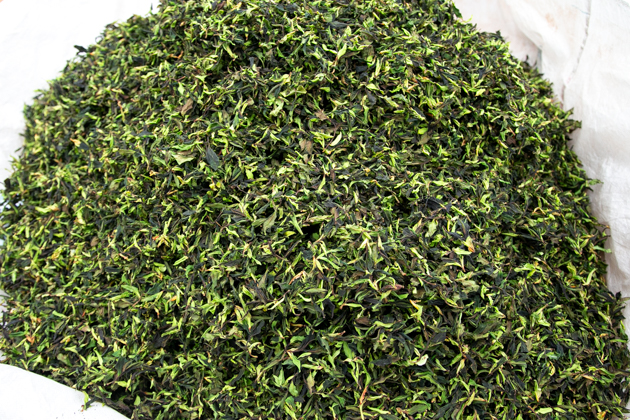
Meticulous Production Management for High-Quality White Tea
The classification of white tea hinges on its natural drying method, whether through sun-drying or air-drying. Despite its seemingly straightforward production process, the popularity of white tea in Yunnan has led to widespread production. However, finding producers capable of effectively managing the production process remains exceedingly rare. 
Seen drying Camellia talaiensis on the floor by the roadside in town. These will undoubtedly be sold as wild tea. While this withering method is unthinkable to us, it is the standard in Yunnan Province.
Camellia taliensis leaves spread out for withering by the roadside—a common sight in Yunnan where they are destined to be sold as wild tea. While this practice may seem unthinkable to us, it reflects the standard approach in Yunnan.
To achieve high-quality white tea with optimal flavor, proper withering is essential. Withering initiates enzymatic oxidation through controlled dehydration, reducing moisture content in the tea leaves. This process demands a deep understanding of the molecular transformations occurring within the leaves and meticulous control over each stage.
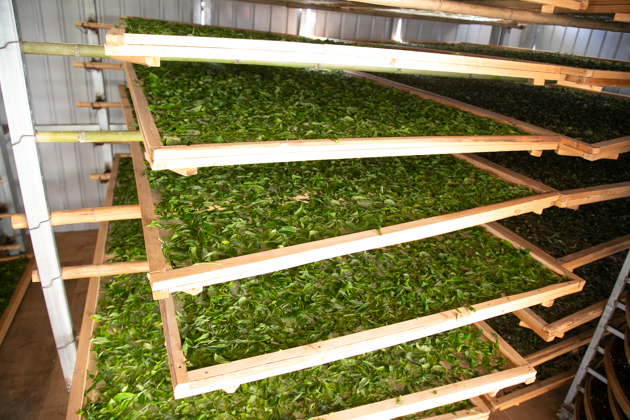
Since we are able to travel to China, during our visit this year, we provided comprehensive guidance on the selection and installation of production equipment, as well as on refining withering techniques. We diligently monitor the condition of tea leaves daily, overseeing production directly on-site. Thanks to these efforts, we’ve successfully crafted white tea characterized by its vibrant green hue and delicate floral aroma.
Typically, issues with picking methods, equipment setup, or withering procedures can lead to improperly withered tea leaves, potentially causing over-fermentation and resulting in a musty odor.
The characteristic of wild white tea
This year’s Da Xue Shan Wild White Tea boasts a high concentration of tender young buds, delivering a gentle and mellow flavor profile. It exudes fragrances reminiscent of Shine Muscat, apple, young tomato, citrus, and herbal notes, with a subtle hint of honey. The tea possesses a robust body, with flavors that expand across the palate and a remarkably long, lingering aftertaste that resonates deeply.

Perfect for cold brew
Da Xue Shan Wild White Tea, like other white teas, offers exceptional flavor when cold brewed. To cold brew, use 5 grams of tea leaves per 1 to 2 liters of water. For optimal results, use cooled boiled water to enhance the tea’s delicate flavors and aromatic notes.
Due to the active enzymes in white tea, it’s advisable to cold brew at a low temperature, ideally in the refrigerator. This method facilitates gradual extraction of the tea’s components, resulting in a refreshing flavor profile reminiscent of Shine Muscat.
How to Buy This Tea
For international customers, please send us an email at info2@hojotea.com.
For customers in Malaysia, Singapore, and Brunei, please click here to visit the product page or make your purchase directly from the shopping cart below.
Da Xue Shan Wild White Tea 2024 Loose Tea / 大雪山野生白茶 散茶
Related Articles
How to get the latest update on HOJO?
1. Follow Twitter, 2. Click "Like" on Facebook, and 3. Subscribe in newsletter. You can have the latest tea news from HOJO.
 Subscribe the Newsletter to enjoy the privileges
Subscribe the Newsletter to enjoy the privileges- You may receive a free sample upon purchase, or you may have the priority to purchase special products. So please remember to subscribe our newsletter as well as the social network.
- Myanmar White Tea Bud 2013 from Guo Gan, Myanmar
- We have released a raw Pu-erh tea, 緬甸白芽茶 2013 (Myanmar White Tea Bud 2013), produced by ethnic minorities in t …
- Yong De Wild White Tea 2025 Loose Leaf Limited Release
- We have released Yong De Wild White Tea Loose 2025. For the 2025 harvest, only the loose-leaf type was …
NEW ARTICLES
 Myanmar White Tea Bud 2013 from Guo Gan, Myanmar
Myanmar White Tea Bud 2013 from Guo Gan, Myanmar- We have released a raw Pu-erh tea, 緬甸白芽茶 2013 (Myanmar White Tea Bud 2013), produced by ethnic minorities in t …
 Yong De Wild White Tea 2025 Loose Leaf Limited Release
Yong De Wild White Tea 2025 Loose Leaf Limited Release- We have released Yong De Wild White Tea Loose 2025. For the 2025 harvest, only the loose-leaf type was …
 Experience the True Freshness of Raw Pu-erh : Tang Jia 2025 Loose Leaf Release
Experience the True Freshness of Raw Pu-erh : Tang Jia 2025 Loose Leaf Release- We have released Tang Jia Raw Pu-erh Tea 唐家古樹生茶 2025 Loose Leaf. Among HOJO’s raw pu-erh teas, Tang Jia Raw Pu …
 Yunnan Chun Jian Green Tea from High Mountain Gardens
Yunnan Chun Jian Green Tea from High Mountain Gardens- Yunnan Chun Jian Green Tea is now available. This tea is made from naturally grown leaves harvested from high …
 Limited Loose Leaf Release of 2025 Da Xue Shan Wild Raw Pu-erh Tea
Limited Loose Leaf Release of 2025 Da Xue Shan Wild Raw Pu-erh Tea- We have released the 2025 loose-leaf version of Da Xue Shan Wild Raw Pu-erh Tea. This tea comes from wild tea …
 Discover a New Way to Enjoy Tea: Cooking Rice with Tea
Discover a New Way to Enjoy Tea: Cooking Rice with Tea- Cooking rice with tea is a simple idea, but it brings surprisingly satisfying results. The tea’s flavour seeps …
 2025 Da Xue Shan Wild White Tea Now Available from Yunnan
2025 Da Xue Shan Wild White Tea Now Available from Yunnan- The 2025 harvest of Da Xue Shan Wild White Tea is now available. Crafted from truly wild Camellia taliensis tr …
 Fresh 2025 Yunnan White Tea – Select Your Favourite Lot Before Blending
Fresh 2025 Yunnan White Tea – Select Your Favourite Lot Before Blending- Freshly crafted in Yunnan and just arrived in KL, our new 2025 white tea is now available at our Gardens Mall …
 2024 Dong Shan Raw Pu-erh Tea – Crafted with the Producer for Desired Quality
2024 Dong Shan Raw Pu-erh Tea – Crafted with the Producer for Desired Quality- We have released the 2024 cake of Dong Shan Raw Pu-erh Tea. Earlier, we offered the loose-leaf version from th …
 Development of Firewood Roasted Hojicha Using Naturally Grown Tea from Yunnan
Development of Firewood Roasted Hojicha Using Naturally Grown Tea from Yunnan- We are currently staying in Yunnan Province for tea production. As the season nears its end, tea trees with pa …
Category
- New Arrival at HOJO Online Shop
- Featured Articles
- Newsletter
- Types of Tea
- Origin of Tea
- Teapot and Tea Equipment
- Tea Column
- How to enjoy tea
- Tea Processing
- How to choose quality tea
- Tea constituents and functional effect
- Safety of Tea
- Foods
- Tea Business Operation
- Hobby and Outdoor Activity
- Ranking of Tea
- Video
- FAQ
- Media Release
Profile

- AKIRA HOJO
- I invite you to experience my tea selections.I was born in Nagano, Japan. In university, I studied agricultural chemistry, and I have the master degree in food science. I worked in Japanese food industry for 10 years. I involved in R&D, QC and QA. As a factory manager, I implemented ISO9000 series and managed the factory.
- The Art of Tea Magazine
- We posted the article on “The Art of Tea Magazine No.9, the magazine is published in Taiwan. We featured …
- New Straits Times
- The Malaysian National Newspaper, New Straits Times featured HOJO Tea on 17-Oct-2007.
Shop Info

Address:Lot No. T-215, 3rd Floor, The Gardens Mall, Mid Valley City, Lingkaran Syed Putra, 59200 Kuala Lumpur
Tel: +603-2287-4537
Business Hour: 10am to 10pm














